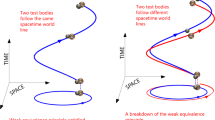Abstract
THE strong form of Einstein's equivalence principle, which dictates that gravitational binding energy will suffer the same acceleration in a uniform gravitational field as all other forms of matter and energy, can be tested by comparing the accelerations of the Earth and the Moon towards the Sun. If the Earth's gravitational binding energy, which contributes ∼5 parts in 1010 of its total mass, does not gravitate in the same way as other kinds of mass and energy, the Moon's orbit will be distorted in a characteristic way with an amplitude large enough to be detected by lunar laser-ranging data. But as Nordtvedt1 has pointed out, such a test is accurate only to the extent that no interfering force, such as a very feeble composition-dependent 'fifth force', fortuitously cancels a gravitational binding energy anomaly. Here we review laboratory upper limits on 'fifth forces' to set an upper limit of 1 part in 1012 (95% confidence level) on the Earth–Moon acceleration difference due to non-gravitational forces. Existing lunar-ranging data then verify the strong equivalence principle to an accuracy of 3%, and improved analyses of the lunar data should bring this precision down to the 0.2% level.
This is a preview of subscription content, access via your institution
Access options
Subscribe to this journal
Receive 51 print issues and online access
$199.00 per year
only $3.90 per issue
Buy this article
- Purchase on Springer Link
- Instant access to full article PDF
Prices may be subject to local taxes which are calculated during checkout
Similar content being viewed by others
References
Nordtvedt, K. Phys. Rev. D37, 1070–1071 (1988).
Shapiro, I. I., Counselman, C. C. III & King, R. W. Phys. Rev. Lett. 36, 555–558 (1976).
Williams, J. G. et al. Phys. Rev. Lett. 36, 551–554 (1976).
Roll, P. G., Krotkov, R. & Dicke, R. H. Ann Phys. N.Y. 26, 442–517 (1964).
Braginsky, V. B. & Panov, V. I. Soviet Phys. JETP 34, 463–466 (1972).
Heckel, B. R. et al. Phys. Rev. Lett. 63, 2705–2708 (1989).
Peccei, R. D., Sola, J. & Wetterich, C. Phys. Lett. B195, 183–190 (1987).
Allen, C. W. Astrophysical Quantities (Athlone, London, 1976).
Dziewonsky, A. M. & Anderson, D. C. Phys. Earth planet. Inter. 25, 297–356 (1981).
Morgan, J. W. & Anders, A. Proc. natn. Acad. Sci. U.S.A. 77, 6973–6977 (1980).
Ringwood, A. E. Origin of the Earth and Moon (Springer-Verlag, New York, 1988).
Author information
Authors and Affiliations
Rights and permissions
About this article
Cite this article
Adelberger, E., Heckel, B., Smith, G. et al. Eötvös experiments, lunar ranging and the strong equivalence principle. Nature 347, 261–263 (1990). https://doi.org/10.1038/347261a0
Received:
Accepted:
Issue Date:
DOI: https://doi.org/10.1038/347261a0
Comments
By submitting a comment you agree to abide by our Terms and Community Guidelines. If you find something abusive or that does not comply with our terms or guidelines please flag it as inappropriate.



